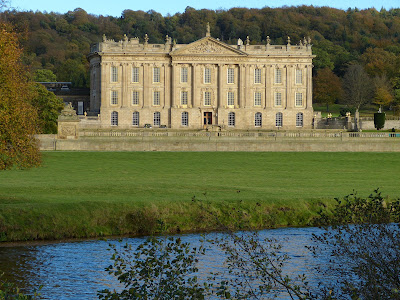Blenheim Palace. Chatsworth House. Downton Abbey. The English landscape is littered with names that project a certain image of Englishness. Like those names I just listed, this image blends reality and fiction, and is maintained by its consistent manufacture on screen, in literature and as tourist attractions.
To many inside this country, and beyond, the country house is a dominant feature in the cultural fabric of England. It’s up there with tea, rolling green hills and the Royal Family.
How did this happen? In her new book, Stephanie Barczewski sets out to answer this question of ‘How the Country House Became English’.
 |
| Chatsworth House (2014) |
An essential for fans of English country houses
I have visited well over 100 English country houses in my life, many on multiple occasions. I’ll never look at them the same way again having read this book. It’s brought into focus many of the questions I ask of a property, which until now haven’t considered the broader context of local and national history.
Until now I’ve tended to look at each house in isolation. Now, even though I’ll continue to enjoy features such as priest holes, abbey ruins, classical columns and Grand Tour souvenirs, I’ll also have a new appreciation of the house as a whole.
This book is not light reading, but it is rewarding and worth the effort. Barczewski is Professor of Modern British History at Clemson University, South Carolina. This is her second work on country houses. It opens with a discussion of how the TV series Downton Abbey, Brexit and the work of The National Trust have nurtured nostalgia, helping to shape perceptions of Englishness.
Houses that embody history
In her book, Barczewski highlights how English country houses reflect ‘moments of disruption in English history’. Notably, the Dissolution of the Monasteries from the 1530s onwards, and the English Civil War, 1642–1651.
The Dissolution of the Monasteries saw massive upheaval in land ownership. Nearly one thousand religious institutions were closed, with ownership of vast tracts of land passing from the church to private individuals.
Many grand houses were built either in or from the ruins of abbey churches, cloisters and other monastic buildings. The Reformation also spawned a host of priest holes—secret spaces built into houses where Roman Catholic priests could hide during searches.
Over a century later, the English Civil War brought damage and destruction to country houses across England, and many properties were confiscated. The end of the war, and the restoration of the monarchy, saw estates returning to their owners and some houses being rebuilt.
These disruptions were followed by a period characterised by Barczewski as the ‘non-revolution’ in England. This is from the Glorious Revolution in 1688 through the seventeenth and early eighteenth centuries, when England endured long wars with Revolutionary France. In this period English country houses came to represent continuity—and it’s when many of today’s classical houses were constructed.
 |
| Athelhampton House (2016) |
The Englishness of the country house
Barczewski spends three chapters discussing the relationship between English country houses and the many foreign influences on it. She makes the point that, with rare exceptions, there is no such thing as a ‘British country house’. Those in Scotland and Wales remain largely distinct.
Most of today’s English country houses were built after 1600, as Britain became an increasingly imperial power. The Americas and India exerted some influence, as did the Grand Tour, which took so many of the wealthy to southern Europe.
The twentieth century transformed the condition of English country houses. Many were demolished, while a host of others became heritage sites with the expectation they would present a comfortable view of history.
She closes this section by saying:
This book argues that such expectations are the result of the invention of the ‘English’ country house in the nineteenth century. After the French Revolution contributed to the elevation of political stability and cultural continuity as key components of English identity, English country-house architecture became more isolated from the continent and more referential to national history.
A wealth of stories and information
 |
| Kingston Lacy (2016) |
On a personal note, I was pleased to see considerable discussion of Kingston Lacy, an English country house local to us in Dorset. Besides being a glorious property, its story is rooted in the destruction and upheaval of the English Civil War. The house itself is presented as distinctly English, with continental influences.
Read more about Kingston Lacy here.
If, like me, you’d like to deepen your understanding of the great many English country houses you’ve visited, or would like to visit, this book is essential reading.
The book has 70 pages of
appendices, references and an index. The appendices include lists of all
English country houses with priest holes, that are built on or from monastic
sites, and that were damaged or destroyed in the English Civil War. There are a
good number of black and white illustrations.
Andrew Knowles researches and writes about the Regency and late Georgian period. He's also a freelance editor and writer for business. He lives in the beautiful Georgian seaside town of Weymouth, Dorset, on the south coast of England, with his wife, Rachel.
If you found this article interesting or useful, and you want to encourage us, help us to keep our research freely available by buying us a virtual cup of coffee. Click the button below.
All photos © Andrew Knowles - RegencyHistory.net



No comments:
Post a Comment